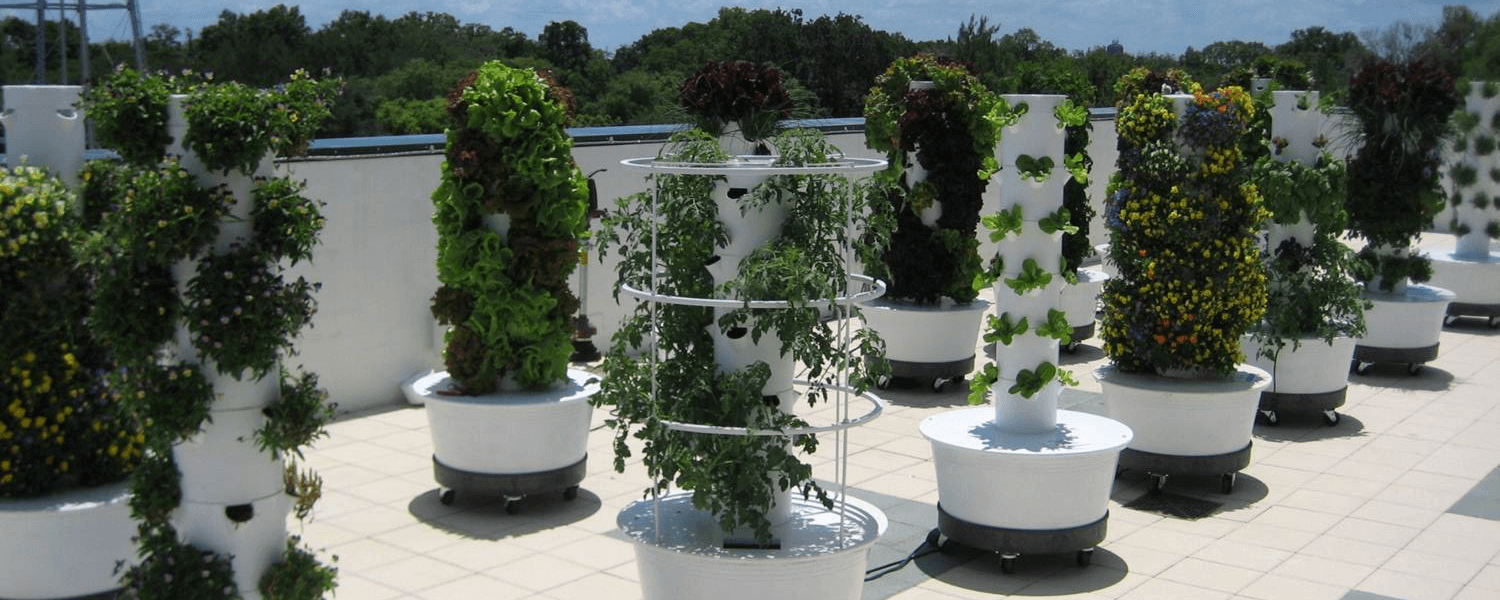
2. Why aeroponics? Shouldn’t I be growing plants in soil?
3. Is hydroponic growing organic? What about organic fertilizers?
4. Why is the Tower Garden plastic? What kind of plastic is used?
Or Click Here to download a handout that answers all four questions.
1. What is a Tower Garden™?
The Tower Garden™ is an aeroponic/hydroponic system that allows you to grow vertically, so that you can grow a tremendous amount of produce in a small space (such as a patio or deck), but without all of the hassle of regular hydroponics. Not only that, the food grown in a Tower Garden™ is more nutritious than almost any conventional or organic produce commercially available.
You can grow in your backyard, year round, and “there is no weeding, tilling, kneeling, or getting dirty! The Tower Garden™ is a plug and play vertical garden. There is no need to have a green thumb.” So far, my family and I have not needed to protect against bugs, and our greens aren’t full of holes where bugs have been munching, as was typical for our traditional garden!
2. Why aeroponics? Shouldn’t I be growing plants in soil?
The short answer is: If you look at the facts, growing in soil is no longer a sustainable way to grow food for the 7 billion people on the planet. We recommend Vertical Farm by Dickson Despommier for an in depth understanding of the crisis at hand.
The long answer is: Modern times require modern thinking. If you love this planet then consider the environmental cost of trying to feed 7 billion people:
- It takes a land mass the size of South America to feed all the people on the planet today.
- In thirty five years, we will have 10 billion people and we will need a land mass the size of Brazil to keep feeding them.
- The runoff from modern agriculture is creating dead zones in our oceans.
- The mowing down of trees and forests is killing – in an instant – billions of species and destroying the biodiversity of ecosystems that took billions of years to evolve.
- If we can change our ways today, we can allow oceans and forests to return to their wild state. There is still enough life on the planet for the environment to go back to a more natural state. But in order to do this, we have to grow up! Literally – we have to farm vertically. Let the wild return to the wild and let humans think more urban. Give up dreams of going back to live in the wilderness, because we just mess it up when we do. Use modern technology to create safe, nutrient-dense food in a sustainable way. You live in the modern world. You have smart phones and computers and you drive cars and fly in planes. Why not let technology that is grounded in good philosophy help you live a more healthy life and help our planet out at the same time?
To understand aeroponics, first let’s look at what plants do.
What foods do plants eat? Do they eat sunshine, minerals, fertilizer, microorganisms, dead animals, cow dung, water, miracle-gro? What do they eat?
The answer is plants don’t eat anything. Very simply put, a plant utilizes the four elements:
- Air (CO2)
- Water (H2O)
- Earth (provides nitrogen and the minerals from the soil that act as cofactors for all the enzymatic reactions within a plant)
- Fire (photons from the sun for photosynthesis)
From these, they make their own food which they burn to make MATTER. Consider a seed turning into a huge tree. Where did the mass of that tree come from? Well, plants make their own food by way of photosynthesis.
Photosynthesis:
Carbon dioxide + water + light = sugar + oxygen
Then they burn this sugar to make everything else that makes up a tree. Photosynthesis is the basis of life. Plants then feed the animal kingdom one way or another as they are the major source of sugar or carbohydrates needed for animal metabolism.
Today we know that we can substitute sunlight with the exact wavelengths of light that the plant will best utilize. Using artificial light when sunlight isn’t available makes it easy to grow food all year long in any location. You can find grow-lights online or at a grow shop near you.
We can directly feed the plant the minerals and nitrogen it needs without the unnecessary chemicals found in fertilizers. Tim Blank has spent many years researching at the Epcot Land Pavilion at Disney and NASA to figure out exactly what minerals are needed for maximizing plant nutrition and human nutrition. Traditional gardening with soil is either missing minerals today, or it requires a lot of knowledge about fertilizers, micro-organisms to break down organic plant and animal matter to make minerals accessible to plants, etc. We don’t need the soil or the microorganisms in aeroponic growing.
Aeroponic growing is the latest development in hydroponic growing as the roots are not constantly submerged in water. A timer water-drip system allows for the roots to be periodically exposed to water and then air. This increases the rate of growth.
3. Is hydroponic growing organic? I thought that we should only be eating organic produce. What about organic fertilizers?
The short answer: Minerals (things like copper, iron, phosphorus, etc,) are, by definition, inorganic. The word organic actually means carbon-based, or living, which refers specifically to plants and animals. Hence, an earth mineral cannot be organic.
The long answer: In certified organic growing, the fertilizers used must come from a plant or animal base. In hydroponic systems, we use earth minerals, otherwise you’d have dead plant-or-animal matter floating around, and it would rot and stink. The thing is, plants have 16 major macro and trace elements that they require. Whether those come from earth minerals, or from minerals in plants and animals, is irrelevant. An earth mineral cannot be organic. The key difference between field organics and hydroponics/aeroponics is that we utilize earth minerals refined in their purest form so that we know exactly what’s going into the plants in the right formulation to get what we want to get out of the plant.
NASA worked to develop mineral solutions that would put more nutrients into plants so that they could grow a healthier plant (for astronauts in space, because their food sources are so very limited). The question must be asked: if we’re raising nutrient dense, healthier plants for astronauts, why aren’t we doing the same thing in agriculture? And the answer is, invariably, we’ve never done it because we don’t have to. Agriculture is very price-point based; whether it’s organic or conventional, farming isn’t a high profit venture, so farmers put the least amount that they can into producing a crop.
One of our key goals that inventor Tim Blank had with the Tower Gardens™ was to develop a system that you could open up and, without having a bunch of expensive electronic equipment (which you’d typically need to do with conventional hydroponics), set up in 30 minutes. And the one nutrient solution they’d use (as opposed to the dozens they’d need for different crops with conventional hydroponics) would work well for tomatoes, for flowers, for lettuces, for cucumbers – whatever crop they want to grow.
And that’s really what we did with the Tower Tonic™: rich, abundant, ionic earth minerals that are important for plant growth. And those minerals would be nitrogen, phosphorus, potassium, calcium, magnesium, sulfur, and trace minerals, like boron, chlorine, manganese, zinc – these are all essential for good, healthy plant growth. But in addition to that, we have a wide range of trace minerals that are also important to human health, and they’re in that nutrient solution in very small amounts, and basically the plant may or may not need to use those minerals but they are available for take-up to help aid in the nutrition, and the health of the plant.
Also, one of the key differences in the Tower Tonic™ (compared to any organic or conventional fertilizer that’s used in agriculture today) is that we stay away from ammoniacal nitrogen. Instead, we use nitrate nitrogen. A good comparison to human nutrition is the difference between white table sugar and a complex carbohydrate found in a grain or vegetable. Ammoniacal nitrogen used with food crops force quick, explosive growth, which is why modern farmers use it. The problem is that with that kind of explosive growth, you get a weak cell structure; the most important component to every plant and cell wall is calcium, and when a food crop is forced to grow quickly like that, it becomes more susceptible to insect damage and pest damage. Just like if we were to eat lots of table sugar: we get quick energy, and we crash later – our immune system is weakened, we feel tired, etc. But eating a complex carbohydrate gives our bodies longer-lasting energy that doesn’t take a toll on our health. The same is true for food crop plants that are grown with nitrate nitrogen.
There are several dozen differences between the Tower Tonic™ and conventional hydroponic solutions and systems, but how we feed our plants is just one of the key differences: it’s rich in calcium, and rich in trace minerals that are important to people. Balanced plant health and wellness, along with human health and nutrition, is at the center of what we’re about.
4. Why is the Tower Garden plastic? What kind of plastic is used?
The Tower Garden™ is a precision growing system. Much like owning a high quality blender or food processor, the Tower Garden cannot be made reliably and even sustainably with clay or earthen material. It is a step above the typical hydroponic systems which use Styrofoam or non-food-grade plastic.
The plastic is made from polycarbonate (food grade plastic). It is BPA free, and the best USDA approved plastic that you can buy.
The most important question is: will the plastic break down in the sun? If it breaks down in the sun there is leaching, so we took every effort to make sure this will not happen, and that this is a product that will last a lifetime. Tim Blank invested in double UV stabilizer to protect the plastic from breakdown and leaching. He also spent extra for opaque plastic, which helps keep roots cooler, keeps algae down, reflects light back to the plant, and keeps from inside-heating and breaking down.
Many people who worked on the product were from the health industry and took a great number of safety/health measures to make sure we had the BEST and HEALTHIEST technology on the market today, just like Juice Plus®!!




Are any of the nutrients in the Mineral A & B Nutrient solutions from Tower Garden Cancer promoting.?
A member of my family has a Blood Cancer condition so we are very concerned about the contents of Nutrient Solution A & B
Hi Elizabeth,
Tower Tonic A & B are the essential minerals in solution needed for plants to provide nutrients for human cellular performance. As to whether any of these earth elements cause cancer, I am unaware of any!
Does running a tower garden use a lot of power?
Hi Katya,
Tower gardens use very little power. The pump itself uses about 40w and is on an automatic timer. When adding the lighting kit for indoor use it adds about 240w which is still very little.
Energy cost varies based on location but if you google energy cost per kwh in your area you should be able to find a calculator. Again it is very little and won’t have much of an impact on your energy bill.
Cheers!